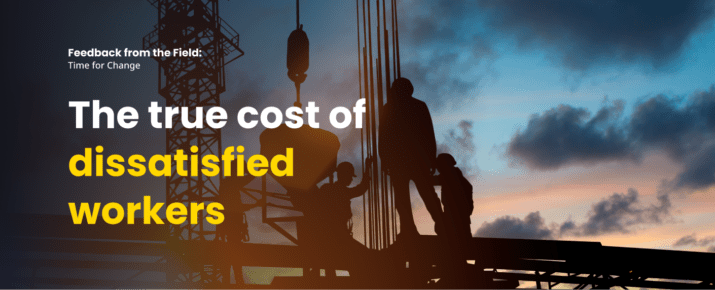Leveling the playing field of employee benefits
Feedback From The Field | By | 25 Jul 2022 | 4 minute read

In recent years, companies have narrowed their attention to managing remote or hybrid workforces — looking at introducing four-day work weeks to mitigate burnout, discussing the ergonomics of work-from-home setups and introducing new tools for video conferencing and messaging. While these conversations are great as we collectively step into the future of work, they seem to center around only the workers who can work remotely.
Employee benefits are at the heart of a fair workplace, but ensuring equity in these benefits can often feel like a game where the rules are not always the same for everyone. Todd Taylor, CEO of Taylor Benefits, emphasizes that businesses must reevaluate their approach to ensure all employees, regardless of their position, have access to comprehensive benefits that support their needs.
It’s not all fair play in the world of work. Businesses often have a blind spot when it comes to the experiences of their frontline workers—those whose jobs require them to show up in person, often in demanding or dangerous roles. Those on the frontline have kept our cities, hospitals, communication abilities and overall economy ticking while most businesses shut down. They’re the first to be lauded as heroes for the work they do, yet when it comes to the rollout of new technology and company-wide benefits, they’re often left in last place.
It’s high time we brought the frontline to front of mind.
SafetyCulture dives into tailoring benefits to those on the frontlines of your business to create parity when work conditions cannot be mimicked like for like.
“Tech Out” Your Teams
Equipping your frontline teams with the right technology for their role’s specific needs is vital. Just as you wouldn’t expect your desk-bound employees to work without a computer, you shouldn’t expect those on the frontline of your business to be efficient and successful without the proper equipment as well. Your frontline workers need the ability to engage with the business where and when their work takes place. The technology used by your organisation shouldn’t leave them feeling as if their needs are an afterthought.
Refrain from slowing your frontliners down with clunky systems and ensure that the software used by your organization is mobile-friendly. This should extend beyond the applications and programs required to perform a deskless worker’s tasks and include the communication and collaboration tools needed to stay in touch with the business and their fellow employees. Mobile-first apps are easily accessible for frontline workers and can be integrated back into your in-office system so your entire organization has access to a centralized platform that allows them to work, communicate and collaborate in one place.
Bridge communication gaps
With the right tech in place, you can begin to evaluate your organization’s communication strategy with your frontline teams in mind. In a recent SafetyCulture survey of frontline workers across the United States, the United Kingdom and Australia, 26% (one in four) said they feel disconnected from their HQ colleagues.
Don’t assume information about company updates, industry-wide news, or upcoming events will reach all the way from the office to the field or front line if you don’t work to connect the gap. Establish an ongoing line of communication that all employees can count on, ensuring that everyone across your organisation is kept in the loop, no matter where their work is taking place.
Company-wide messages offer a great opportunity to acknowledge the hard work your frontliners do every day. Highlight a specific person’s contribution, celebrate birthdays or call out team successes—get creative with your communications to assure employees feel both valued and seen.
TIP: Remember to consider the schedule of your frontline workers when sending communications. Is it safe for them to read messages during their workday? If so, do they have the downtime to engage or respond? Work with their schedules to avoid creating an ongoing interaction they are missing out on.
Make Benefits Truly Beneficial
While all employees within your organization might receive the same overarching benefits package, not all employees receive the same daily benefits. Employees who spend the majority of their workday outside of the office or un-tethered to a desk tend to miss out on the little “perks” most companies offer—especially when factoring in the additional benefits associated with working from home. One in three (39%) of the frontliners who participated in our survey admitted that they don’t feel like they have access to the same level of benefits and flexibility as their HQ colleagues.
It can be difficult to mimic these benefits when looking to include team members who work beyond the walls of a typical office space and don’t have the ability to work from home. Instead of looking for ways to replicate, build a separate perk plan for employees on the frontline. Use your organization’s values as a starting point and define how they could be conveyed through frontline-specific benefits.
The same applies to when you want to relocate talent. Since relocation means uprooting one’s life altogether, having truly beneficial benefits in such situations can help make your target talent more willing to move. You can learn more about relocation on this employee relocation guide from ARC or related online resources.
TIP: Feedback is key. Involve your team members in the conversation by asking them what kind of perks they would like to see adopted—examples could include catered lunches, reimbursement for daily commutes, free breakfast or company-paid parking.
Learn to bend so your employees don’t break
Working from home offers a new level of flexibility that is impossible to match for those whose job requires them to physically show up each day. Consider offering frontline workers additional days off or even small blocks of PTO that can be used for mid-day appointments or errands. During the actual workday, encourage team members to take breaks and ensure they have the space and time to do so.
Counseling services, improved access to training and growth opportunities, company-sponsored wellness offerings like fitness classes or gym memberships, better workday support or additional sick leave could all be incorporated into your frontline-specific benefits package to provide flexibility and help mitigate the burnout so many are feeling.
In high stress or demanding physical roles, the addition of occasional free donuts or a passive “thanks” isn’t going to be enough to show employees you value them. In fact, snacks and foodstuffs should be provided as standard to demonstrate that staff are appreciated unconditionally.
However, snacks must always be allergen-free and safe for all employees, as the clean-label brand Safe + Fair rightly says “there is nothing more important than food safety”, especially when a mistake could lead to serious illness. The responsibility is on those at the top to set the tone and update company benefits to ensure they are truly beneficial for all.
Frontline workers showed up for us all when life as we knew it journeyed into the unknown. Now, as we continue forging the path toward the future of work, it is time we showed up for them. SafetyCulture’s mobile-first solutions help businesses revolutionize and digitize their processes to empower all employees, no matter where their work takes place.
Important Notice
The information contained in this article is general in nature and you should consider whether the information is appropriate to your specific needs. Legal and other matters referred to in this article are based on our interpretation of laws existing at the time and should not be relied on in place of professional advice. We are not responsible for the content of any site owned by a third party that may be linked to this article. SafetyCulture disclaims all liability (except for any liability which by law cannot be excluded) for any error, inaccuracy, or omission from the information contained in this article, any site linked to this article, and any loss or damage suffered by any person directly or indirectly through relying on this information.





